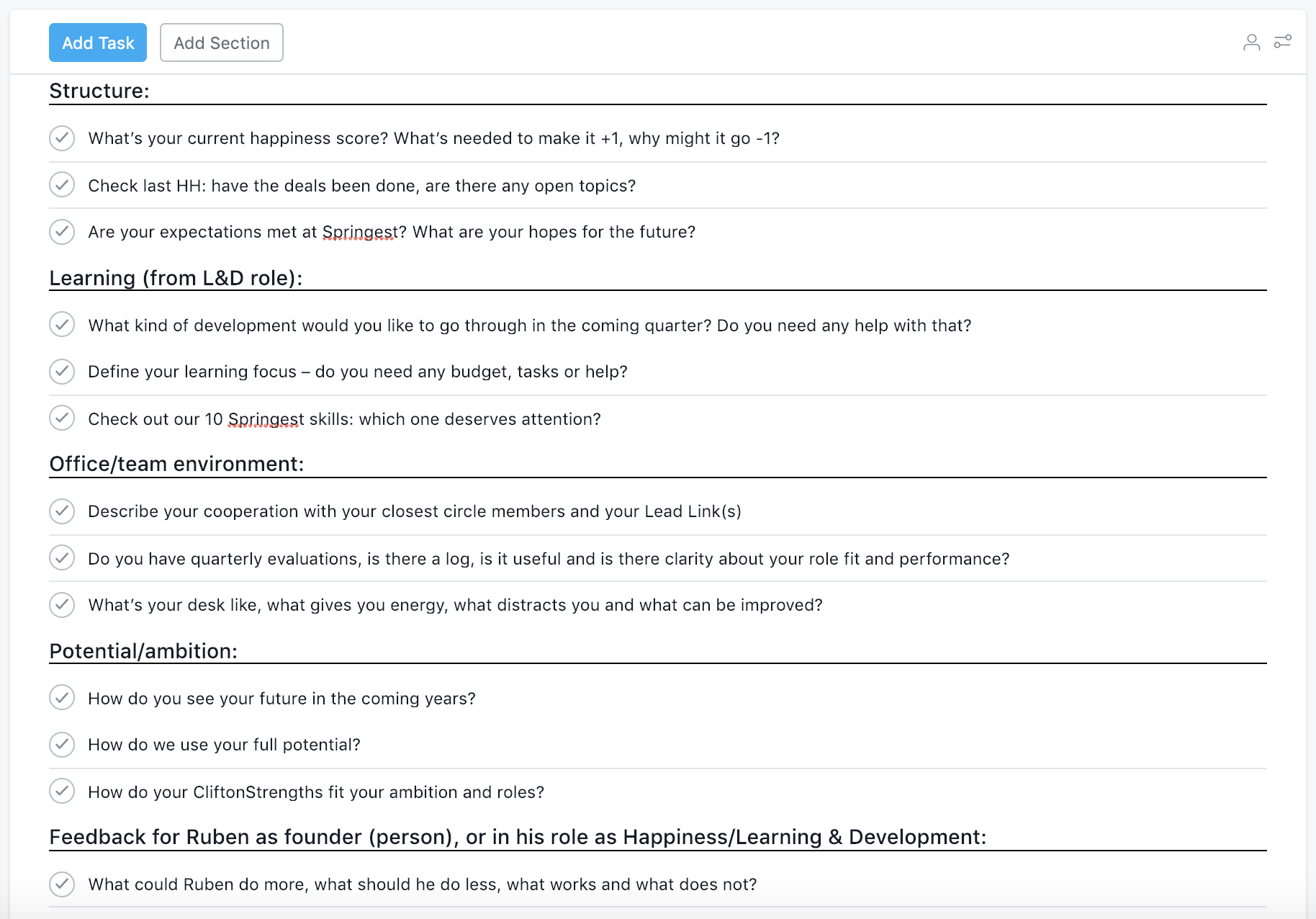

Culture 2.0 – handling happiness in fast growing companies
6 mins read
Tue, Jul 21, '20
Teams & Organizations


Jonathan Davies
6 mins read
Tue, Jul 21, '20
A lot of companies feel that, in order for employees to be happy, you need to give them something. A salary. Recognition. A future. Heck, a ping-pong table. But these things give employees something they desire.
Robert McKee said: “Desire demands deeds. To rebalance life, the core character must act. However, desire only answers the what. Motivation answers the why.” In other words, you can keep giving the things that employees want, or you can dig and find out why they want something, and why that affects their happiness. Because quite often, us humans don’t have all the answers. Find the reason a (large) group of employees wants something and you can anticipate what your company needs to do to keep employees happy – even the less vocal ones.
“What kind of economic engine would keep churning if we believe that not getting what we want, would make us just as happy as getting it? A shopping mall full of zen monks wouldn’t be profitable – they wouldn’t want ‘stuff’ as much.”
Dan Gilbert probably said it best. Society as we know it has indoctrinated us to get ‘stuff’ to be happy. Now you already know that you can’t just give stuff and hope employees will be happy. You have to seek the underlying motivation behind it. Why would they want a ping-pong table? Maybe competition, or exercise, is a key part of their identity. Regardless, these elements are far from universal and differ highly per organization, department or even team. The good news: there is one universal truth in happiness.
The Harvard study of adult development - arguably the most authoritative study on what happiness is - has found consistently that good relationships keep us happier and healthier. Loneliness kills – good social connections are important. It’s not just the number of relationships either, it’s the quality. If you’re in a fast growing company, you’ve probably already figured out where I’m going with this. There, employee happiness is a bigger challenge than in other companies. No, it’s not because most developers are introverted – the few studies that have tackled this subject have shown this is a myth.
In fast growing tech companies, developers are many and they have a lot of power. The nature of their work is less team-oriented, more individual. It’s also something that takes an incredible amount of focus and a mindset that challenges the boundaries of creativity and logical thinking. The result? Their need to build work-based relationships is diminished. It’s a high-focus, high-impact job. This research shows the main causes of unhappiness among developers. The most important cause for unhappiness? Inability to solve a problem. Something that can be solved by better relationship building. The fifth cause in the top 5 of factors that make a developer unhappy further proves this point. "Feeling inadequate at work" is something that can be solved by talking and building relationships with people that directly impact a developer’s performance – not just management.
We asked Ruben Timmerman, founder and CEO of Springest, what he thinks:
“Happiness starts at recruitment. Recruiting someone who expects a corporate structure would kill any chance of becoming a happy ‘Springeteer’. Making bad fits happy is also too expensive because it means you’ll make others unhappy. Being open about your culture is vital to getting the right people. The amount of freedom we give to employees certainly demands it – not everyone can handle it, but those who do, thrive.”
Ruben sparks an interesting point. Not just in developers, but in all people, high growth companies need to be increasingly discriminative to hiring people that are a good fit. A lot have. So if you hire someone smart, why do you need to tell them what to do? Don’t they know this best themselves? Not all companies will go through a radical, structural change and adopt Holacracy as their flexible company structure, but today’s employees scream for freedom – and they should be heard. We’re no longer working the conveyor belt, trying to operate a machine as precise as we can. We’re using our minds to create scalable solutions, often in markets that never saw an approach like this before. We disrupt. Who are we then to tell someone how to do their job?
“In the end, engaged and happy employees are the face of our company to our clients. I think everyone would prefer to work with engaged and happy employees. It’s more fun to work with someone who likes what they do, so it has a huge impact on our business.”
Ruben Timmerman, founder and CEO of Springest adds:
“There’s no direct quantification. If you really wanted to, you’d have to A/B test and we’re too small to do that. I definitely have anecdotal evidence of a lot of people saying that when they don’t feel right, they don’t work right. There is logical deduction here: if you’re unhappy, you could be sick more often, communicate badly, be less approachable, get work done too slow – the list goes on. If all these things are acceptable and binary, then you can say the grand conclusion is that a lack of happiness has a negative impact.”
Everything binary is quantifiable. Success or failure, truth or lie, loyalty or betrayal. So too with happiness. A decent way to measure is to start with pulse surveys – just ask employees to rate their happiness on a scale of one to ten, every six weeks or so. This gives a baseline of what’s going on in your company. Then it’s important to find the outliers. Did someone grade far below average? Then it’s time to find out what’s wrong. Tools like Tiny Pulse allow you to send a direct message to feedback givers, even if they choose to remain anonymous.
Beyond that, listening is a key. Analytics are necessary, but without context, everything is an assumption. Why did your company score particularly high or low this week? Identifying that causality is the only way to actionable insight.
So you’ve heard from Ruben, the founder of Springest, before in this article. Springest is a small company of 55 people throughout Germany and the Netherlands. Ruben’s approach to happiness is progressive, but is it also pragmatic for large companies? After all, he’s the founder but he also holds Happiness Hours (HHs) with every employee, every quarter. Ruben thinks there’s no reason larger companies can’t do this:
“The larger you get, the more resources you’ll have for this. Okay, maybe you’ll need one senior person per location to take charge of HHs. Large organizations look at small ones and say ‘yeah it’s easy for you to say, you’re a small company!’ To which I respond ‘you’re large, you have the money for it’. Smaller companies have more expenses because they can’t scale up yet, and have little cashflow. Next to that, on C-level, I see this as my most important role. Start with happiness and everything becomes easier. If people aren’t happy, you won’t get anything. I know this approach works, because I have the data to back it up. According to TinyPulse, the industry’s average happiness rating is a 7.3. The Springest average is an 8.”
This is the list of questions Ruben will ask during his Happiness Hours (HHs)
It’s clear: it’s time that Internal Communications puts happiness higher on the agenda. Even if they aren’t the ones who report on it, IC can have a huge impact on employee happiness by coaching line management into this type of dialogue and reinforcing the employer brand together with HR.
This is the first chapter of our report. If you're interested in reading more insights from business leaders on scaling their company culture, you can get the free full report here.

